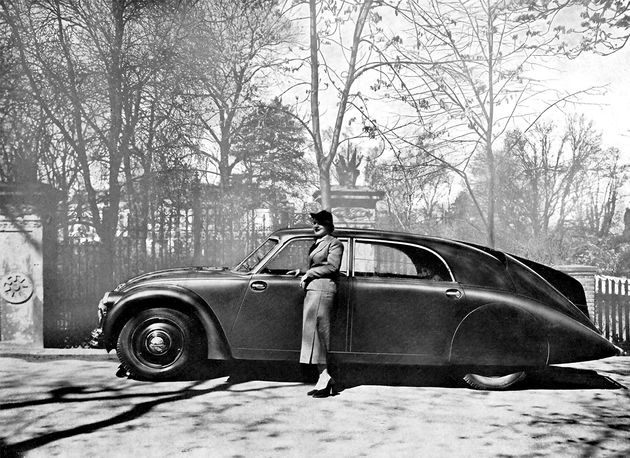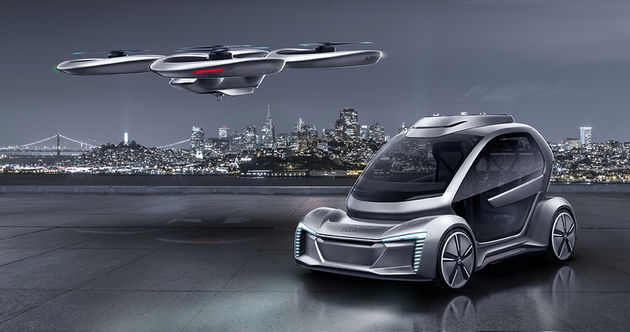 General Motors Firebird I (XP 21). Photo by General Motors Company LLC, courtesy of the V&A
General Motors Firebird I (XP 21). Photo by General Motors Company LLC, courtesy of the V&A
The car is arguably one of the most transformative objects ever designed and the new exhibition at the V&A is a crowd pleaser. But it still offers a serious interrogation of its subject, writes James McLachlan
Remember the future? The future where cars looked like spaceships? Where the perpetually empty road offered endless possibilities? Where you were guided to your destination by a uniformed man in a control tower? Chances are you don’t, and with good reason. This future, envisioned by General Motors for its 1956 film Motorama, never arrived. Cut through the Atomic Age abstraction, and you will be reminded that the car industry has been selling us these dreams, in one form or another, since the days of Henry Ford. GM’s utopian vision opens Cars: Accelerating the Modern World at the Victoria and Albert Museum, at once laying bare the gulf between celluloid perfection and asphalt-hard reality.
In truth, the car has been far more transformative than Jetson-style fantasies. It reshaped our cities, our ideas about personal freedom, and latterly our attitudes to the environment. Few objects have proved so influential, or so divisive. In an era of melting ice caps, gridlocked cities and declining air quality, what to make of a show centred on an object that has contributed to all three?
The direction the car is headed in is under greater scrutiny today than at any point in history, but there have been few serious examinations of how we arrived at this point. Anyone hoping for GM-style future casting, however, will be disappointed. Curators Brendan Cormier and Lizzie Bisley have instead opted to chart the impact of the car from its arrival 130 years ago to the present day – tackling themes such as speed, production and consumerism and approaching the car as a social object. The archival material includes film clips, adverts, car-related fashion, subcultures, posters, paintings, comic books, robot arms and, of course, cars. All sorts of cars.
 French advertisement 1934 for the Tatra 77. Photo courtesy of the V&A
French advertisement 1934 for the Tatra 77. Photo courtesy of the V&A
There is a curvaceous beauty: the Czech Tatra T77 (1934). It was the first aerodynamically designed car; a tricked-out Chevrolet Impala in iridescent green and yellow. There is also an opulent, hand-crafted Hispano-Suiza HB6 (1922), which feels almost quaint in comparison to the unwoke machismo of the 1968 Mustang GT Fastback. There are pretend cars, too, designed as display cabinets for the smaller exhibits. The breadth of material is vast; you could pick an object at random and its accompanying story would be worth telling.
The disjuncture between aspiration and reality is a recurring theme. Around the time the famed Model T Ford was rolling off the production lines in the 1920s, constructivist architect Georgii Krutikov was dreaming of bubble-shaped flying capsules. Krutikov’s otherworldly sketches are shown alongside vintage issues of Popular Science depicting similar sci-fi fantasies. Ford, naturally, has a significant chunk of the exhibition devoted to its methods, which sought to reinvent vehicle production, and society itself. An image of the arch industrialist’s gargantuan River Rouge complex begins a narrative that follows Fordism to its denouement, represented by a series of trade union posters urging solidarity with striking factory workers. Indeed, where this exhibition succeeds most is in joining the dots between the various forces at work – linking material innovation in the oil and rubber industries to the exploitation of workers in the developing world, for example.
Technological innovation led to ever-cheaper cars, but speed was the most seductive promise, realised in the perilous form of a 1953 Firebird 1 Concept Car. Alongside the Firebird is the first ever production car, the 1888 Patent-Motorwagen No 3, by Karl Benz. The tension between these two contrasting objects is heightened when you consider Benz’ creation, which resembles a motorised horse and trap minus the horse, can keep pace with modern day London traffic. Where did the dream go so badly off-track?
 Graham illustrates what humans would look like if they evolved to survive car accidents. Image by Transport Accident Commission, courtesy of the V&A
Graham illustrates what humans would look like if they evolved to survive car accidents. Image by Transport Accident Commission, courtesy of the V&A
The inevitable consequences of the quest for velocity are embodied, quite literally, by the grotesque form of ‘Graham’ – a rendering of how the human body would need to evolve to survive a car crash. Graham’s placement across from a curious display of automotive fashion contains an element of dark humour: look chic as you careen through the windshield! The threat cars pose to the environment is also touched on, but not exhaustively. A Humble advert boasting: ‘Each day Humble supplies enough energy to melt 7 million tons of glacier!’ is all the more shocking for its casual deployment.
Still, you are never far from the idea that cars were, are, and continue to be objects of desire. The aforementioned Hispano-Suiza HB6, designed for heiress Suzanna Deutsch de la Meurthe, has the sort of exquisite joinery found on an oligarch’s superyacht. For the masses, advances in automotive styling lured consumers into a spending cycle where the next and more desirable model was always hot off the production line.
True believers soon rejected the car industry’s prescriptive offerings, birthing a culture of customisation. Hot Rodding, prevalent in California in the 1950s, splintered into various sub-groups. One of these offshoots is captured in a specially commissioned film documenting the tyre-shedding spectacle of car spinning in South Africa, which couldn’t be more at odds with the zeitgeist unless one of ‘spinners’ ran over Greta Thunberg.
 Pop.Up Next, a concept design for a flying car by Italdesign. Image courtesy of the V&A
Pop.Up Next, a concept design for a flying car by Italdesign. Image courtesy of the V&A
The show closes with a giant drone-like vehicle attached to the ceiling; a tentative overture to what may be resting (or hovering) just over the horizon. How soon will it be before airborne cars are the norm? Or perhaps it is more pertinent to ask, how long before the car as we know it becomes obsolete? ‘As quaint as owning a horse’ is how a recent New York Times article put it. These questions are left largely unexplored, and for some this will feel like a critical omission.
Given the scope, the show could easily have sprawled like the never-ending suburbia the car precipitated. Its success lies in the curators’ tight rein on the subject matter. Rigorous, but not pedantic, and with enough visual oomph to keep the casual observer engaged, Cars: Accelerating the Modern World is a crowd pleaser that still offers a serious interrogation of arguably the most pivotal object of the last century.
Cars: Accelerating the Modern World, is on show at the V&A, South Kensington, until 19 April 2020.


















